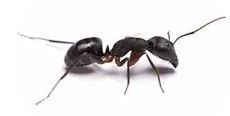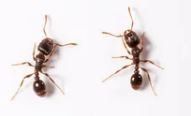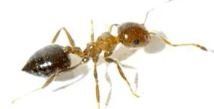Ant Removal
Proudly serving Preble, Darke, Montgomery, & Miami Counties
Ants are the number one nuisance pest in the United States. There are several species, and the method of ant control will depend on what kind of ant problem you have. Ants are social insects that reside in colonies in the thousands. In order to properly eradicate the problem, the entire colony has to be removed not just the ones you can see. So a repellent spray may make things better for that day, but it won’t fix the real problem your experiencing. There are two main types of ant removal problems: ants that have built nests outside and are coming into your home, and the ants that have already built their nests inside of your home. An experienced technician will come to your home, determine the issue, and come up with a plan of action to remove the colonies in a timely manner.
Ant Life Cycle & Habits
Ants are social insects that live in colonies or nests usually located in the soil near the house foundation, under concrete slabs, in crawlspaces, in structural wood, in the yard or garden, in trees, and in other protected places. Ants have three castes, namely queens, males, and workers. Queens and males are the reproductive. Workers are sterile wingless females. New ant colonies are started by a single fertilized queen that lays eggs and tends her brood (larvae and pupae) that develop into worker ants. Tending of the brood is then taken over by the worker, which may shift the brood from place to place as moisture and temperature fluctuate in the nest. When workers forage for food for the queen and her young, they often may enter houses and become a nuisance by their presence and contaminate food.
Solve Your Pest Problem Today! (937) 884-5646
Ant Overview
Ants are social insects that live in colonies that can have 1 or more queens. An average sized colony is comprised of around 4,000 ants. They can colonize in the ground, leaf clutter, or inside a structure. They have a 3-part segmented body: the Head, Thorax, and Gaster. Reproductive ants are winged. These insects can carry 20 times their body weight and live an average of 45-60 days. Carpenter ants are also a frustrating pest that is quite active in the summer. When they come into your yard, they may chew their way into your home. This can lead to frustrating repair costs that add up over time.
Ant Identification
There are several kinds of ants that may occur in and around the home ranging in size from about 1/32 to 3/4 inch long and colored yellowish, light brown, reddish-brown, brownish-black, or jet black. Ants, as all insects, have three body regions. head, thorax, and abdomen. Most are wingless, but the homeowner sometimes may confuse swarming, winged ants with swarming, winged termites, causing alarm. Ants can be easily distinguished from termites by several characteristics:
- Ant bodies appear constricted or pinched in at the waist (shaped like a figure 8), while termites do not have the waist constriction.
- Ants have elbowed antennae, while termites have straight, bead-like antennae.
- The forewings of ants are much larger than the hindwings. Termites' wings are equal in size and shape.
- Ant wings are transparent or brownish, while termite wings are milky-white or grayish and longer than the body.
- Ant wings are firmly attached, while termite wings are easily removed or shed (fall off).
- Life Cycle and Habits
Complete Ant Colony Elimination!
Ants, and some of the other pests in your home, actually live in nests outside. The key to getting rid of ants is to target them where they live. By applying Termidor to the outside exterior foundation of your house, We will create a protection barrier. This liquid technology cannot be seen, smelled, tasted or avoided by Ants, making it effective in killing every member of the Ant colony. We Call this the Transfer Effect, every Ant that come in contact Termidor becomes a carrier of the product and transfers it to other Ants it comes in contact with. The end result is complete elimination of the entire Ant colony that has infested your property!

Carpenter Ant
These ants get their common name from their habit of hollowing out galleries in wood. Known mostly by their size and color, carpenter ants are commonly black. their color can range to a little red. Most Carpenter ants establish their first nest in decaying wood and later expand this into sound wood. inside, nest are located in wood preferably softened by fungus rot.

Odorous House Ant
the pungent, "rotten-coconutlike" odor given off when this ant is crushed gives it its name. About 1/16-inch to 1/8-inch in size and dark brown to black. inside, these ants usually construct their nests in wall voids especially around hot water pipes and heater, in crevices around sinks, cupboards etc.

Pavement Ant
This ant gets its name from commonly locating its nest in or under cracks in pavements. Pavement ants are 2.5 to 3 millimeters long and are light brown to black in color. inside, pavement ants will occasionally nest in walls, in insulation, and under floors.

Field Ant
Field ants can be large, often confused with Carpenter ants. They can be black, brown, tan, reddish, and black in color. Field ants construct their mound of plant materials, often grass but also twigs, leaves, and or pine needles. these ants feed primarily on honey dew from aphids, mealybugs, scale insects, etc.

Pharaoh Ant
These Ants are tiny; 2 millimeters long. They are yellow bodied with black and red markings on their abdomen. Pharaoh Ants will typically nest in hidden, well-protected areas such as wall voids, and insulation.
Brands We Use



Counties We Service
Preble County • Darke County • Montgomery County • Miami County
AllPest Pest Control & Wildlife Removal
6866 Georgetown Verona Rd
Lewisburg, OH 45338
(937) 884-5646
oswaltallpest@gmail.com
